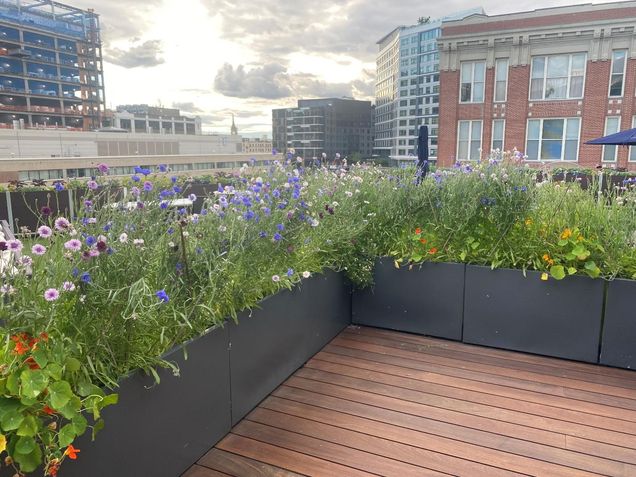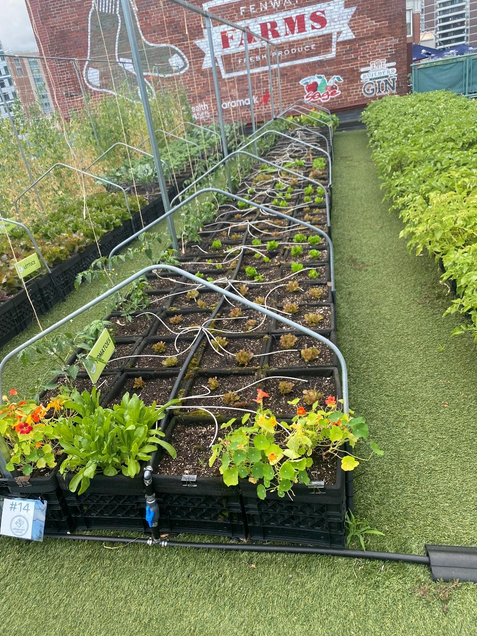Student Work Wednesday- Featuring Emily Shawn
This week we’re highlighting the work of Gastronomy graduate, Emily Shawn. Last spring, Emily completed a project about food innovation at Fenway Park for the Food Waste course taught by Steve Finn here at Boston University’s Metropolitan College.
Exploring Food Innovation and Food Waste Reduction at Fenway Park
Swing, battah, swing! The sounds of Fenway Park resonated, practically surrounding me as I made my way through Lansdown Street. The unmistakable scents of baseball food – Fenway Franks, giant salted pretzels, popcorn, cracker Jacks – wafted over me, along with something fresh and summery on the mid-summer breeze. A baseball game at Fenway Park is a full heart-of-Boston sensory experience, from the thrill of flying baseballs, the fascinating people-watching, and the unforgettable culinary experience. When my Food Waste: Scope, Scale and Signals for Sustainable Change class visited the park in late June, we were lucky to have great weather and even catch a glimpse of a rainbow up above the Green Monstah.
I have to admit I was not expecting our tour of Fenway to include a beautiful garden, fresh veggies, and the best carrot I’ve ever eaten. After leading our class through the multiple kitchens within Fenway, through the glorious MGM concert hall, up above the Green Monstah and through the VIP kitchens, Senior Executive Chef Ron Abell directed our group up to a rooftop garden with lush flower beds and an equally stunning view of Boston.

The sight took my breath away, as did inhaling the refreshing earthy-floral scent so unexpectedly delightful in a decidedly urban city block.
“Who knows what these are?” Ron asked, pointing to several plants. Our class identified the herbs – lavender, basil, chives – and then stepped across a gate to enter the rooftop garden.

Fenway Farms, an urban rooftop garden grown in milk crates, provides fresh organic home-grown vegetables for thousands of baseball fans through the season. The use of rooftop space for growing plants provides an excellent atmosphere for vegetation to grow right next to the kitchen, in full sunshine and up far too high for any ground animals to reach.
“Let’s test your knowledge,” Ron offered, pointing at each plant to see who in our class could name the vegetables and pollinator flowers. Kale, lettuce, sugar snap peas, eggplant, tomatoes, nasturtiums, carrots – row upon row upon row of plants, all thriving and diligently cared for. The garden felt, in a way, magical.

As our class wandered through the garden in a sort of awe, Ron explained to us that he believes in cooking and eating seasonally. You can’t make butternut squash taste good in early May – it’s not right. And what better way to eat in tune with the seasons than a fresh vegetable garden, right here above the baseball field?
The garden was, in fact, practically the opposite of what I would have expected baseball food to be.
“A lot of this goes up to the VIP boxes,” Ron explained, twirling a freshly picked carrot in his hands. He explained that the box seats offer guests meals including fruit trays and wholesome salads all grown right here.
“Try this,” Ron then said, breaking off the carrot top and handing it to me. I frowned – don’t carrot tops usually go in the garbage? However curiosity got the best of me so I took a bite. It was crunchy, almost peppery, like a cross between lettuce and cilantro – surprisingly tasty!
As we chomped on the carrot and the carrot tops, Ron explained how he made sure the staff in his kitchens knew how to use vegetables, how to pick them, how to properly cook them, and how to slice and prepare them so as to minimize food waste in any fashion. His passion for food – good, seasonal, delicious, expertly-prepared food—was evident and drew us in as he talked about how the garden served the kitchens, staff, and guests of Fenway Park.
We discussed the many unique challenges of reducing food waste in stadium settings, to which Ron and his team are well-attuned, including the challenge of reducing waste in the luxury suites – which has parallels to other settings (ex. cruise ships, casinos) where consumers are paying up for a high-end experience with an expectation of abundant food. Indeed, Ron explained that a large percentage of food waste at Fenway involves produce, as patrons often bypass salads and fruit trays for more traditional ballpark fare.
Our class collectively shuddered: standing here in this beautiful garden, nibbling a carrot fresh from the earth, it was such a shame to think of any of these plants going to waste rather than nourishing people.
Ron’s dedication to the rooftop garden and ensuring the plants are used effectively in the kitchen really brings home how evident it is that as consumers (in all venues) we need to do better — to ensure that we properly value our food resources so that all of the effort put into growing, distributing and preparing nutritious food for us is not also lost with discarded food.
At the same time, standing in the garden myself where I could see, smell, hear and taste the fresh veggies while also enjoying a fabulous view of the city of Boston really highlights the importance and benefits of urban garden access. When one is able to name every plant in a garden – our class came close but Ron Abell knew them all – the food feels even more important, meaningful, and (dare I say) delicious.
We are grateful for the tour and discussion and Ron’s dedication to his craft, which includes minimizing the waste of food in a unique and challenging environment.
—
A lesson I took into the future from eating leafy carrot tops is to find more uses for foods that surprise me. If you’re looking to keep your carrot tops out of the trashcan, try out this carrot top pesto recipe here: https://minimalistbaker.com/the-best-carrot-top-pesto/
You can also learn more about the Fenway Farms rooftop garden here: https://www.mlb.com/redsox/ballpark/green-initiatives/fenway-farms